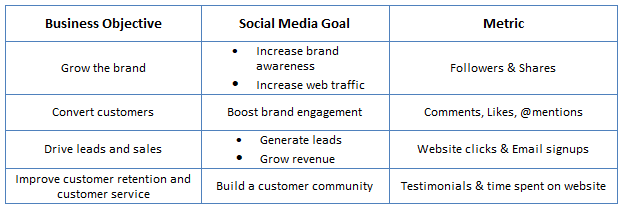What Makes an Effective Social Media Marketing Strategy?
Give your social media team some direction by planning your next move
Have you thought of an exciting social media campaign? Or want to create a social media platform for your business? Before the fun begins you need to sit down and draw up a marketing plan to help strategize and ultimately maximize the potential of your campaign idea. In this article, we’ll list the important aspects of a great social media marketing strategy so you can achieve all your desired marketing goals.
Set SMART Goals
How are you expected to measure your success without first setting business goals? Align your business against specific goals to quantify how well you are doing throughout the year. Exceeding your goals? Great, keep it up! Falling behind? What can you adjust to ensure you get back on track?
Your goals should be: specific, measurable, attainable, relevant and time-bound. (SMART) Think about this when you’re setting your social media goals. Typically, you’ll have a couple of goals to seriously focus on in SMM. These can be from any of the following:
⦁ Increase brand awareness
⦁ Increase web traffic
⦁ Generate leads
⦁ Boost brand engagement
⦁ Build a community
⦁ Grow revenue
You should choose to focus your marketing efforts on one or two primary goals and one less critical secondary goal. This is more beneficial compared to the counterproductive method of hedging your bets across all available goals. Working with too many goals in mind is distracting and you’ll end up with very little accomplished.
Find Your Target Audience
Above all else, the right audience can really dictate the effectiveness of your content marketing. They are the vehicles to your success. This should culminate in the creation of your buyer personas – do this to find your ideal customer.
Buyer personas are realistic and detailed snapshots of a specific customer type as opposed to simply listing off basic characteristics. This will allow you to produce carefully crafted messages or content that speaks directly to your targeted customer group:
⦁ Who are they? (Demographic)
⦁ What services are they interested in?
⦁ What social platforms are they on?
⦁ What time do they usually look for the content?
⦁ How do they consume the content?
⦁ Why do they consume the content?
Analyse your Competitors
Identify your market competitors – particularly focusing on those who use social media marketing to grow their business. What’s their focus? Who are they targeting? What keywords do they use? Do this by using Google to search for keywords commonly associated with your niche and list off the other businesses that appear in SERPs.
Your analysis should tell you how effective your competitors are across the various social media platforms. You need to be ruthless in your analysis. If they’re strong on Twitter, focus your efforts on Facebook and vice versa. Target areas where your competitors are weak.
Buzzsumo is a competitor analysis web app that allows you to check how your competitors are doing on different social media sites. Analyse your competitor’s most effective social media content and use it as a benchmark, then aim to improve on it for your future pieces.
Audit and Content Calendar
Before launching a successful marketing campaign, you should conduct an audit of your current progress. Your social media manager should be asking the following questions:
⦁ What is or isn’t working?
⦁ Who’s connecting with you on social?
⦁ What platforms do your target audience use?
⦁ How do you compare to your competitors?
After collecting the relevant information and collating it in one location you’ll have a better idea of what to do next. The main objective of a social media audit is to clearly outline the purpose of each active social account. If questions start to arise regarding the effectiveness of one or more accounts – think about removing them.
After auditing your accounts you need to create a content calendar. Make use of Excel to easily create your scheduling format (see example below). Find out when your target market is online and outline an initial posting schedule based on known user engagement. Posting content no one will see is counterproductive and a waste of resources.
Social media posting frequency requires the correct balance. You want to ensure your users are seeing your content, but you don’t want them getting bored or irritated by a sudden deluge of content during those peak hours.
Determine and Track Metrics
Metrics and goals are linked. The metrics you decide to track should correspond with the goals you’ve already determined (see table below). Tracking various metrics can give you an idea of whether or not your investment in social is justified. It’ll also help you to make smarter, more data-driven decisions in the future.
It’s easy to turn to ‘vanity’ metrics such as: Likes, Shares and Retweets, but they aren’t the be-all and end-all. Sure, they are useful when measuring goals like increased brand growth and web traffic - but it’s important to look at other metrics too. This will show you if your work so far has had a positive, bottom-line impact on your business.
The table below is an example of which metric to use for each social media goal related to the business objective:

Wrap Up
A strategy of any type can never be too meticulous, by failing to prepare you are preparing to fail – this is true in all walks of life. Your digital marketing campaign can come apart at the seams if you aren’t knowledgeable or ready to deal with any outcome. Of course, you’re likely to encounter problems along the way – that’s normal - but at least now you’ll be in a better position to deal with them.

